Comorbidity of chronic kidney disease
Page highlights:
Prevalence of chronic kidney disease, diabetes and heart, stroke and vascular disease
In 2011–12, an estimated 2.8 million Australian adults (18%) were living with diabetes, chronic kidney disease and/or heart, stroke and vascular disease.
Hospitalisations with chronic kidney disease, diabetes and cardiovascular disease
In 2020–21, 23% (2.2 million) non-dialysis hospitalisations of people aged 18 or over involved chronic kidney disease, diabetes or cardiovascular disease.
Comorbidities of people receiving kidney replacement therapy
In 2021, 44% of people receiving kidney replacement therapy were living with diabetes.
Deaths from chronic kidney disease, diabetes and cardiovascular disease
In 2021, 58% of adult deaths (99,100) involved chronic kidney disease, diabetes or cardiovascular disease.
What is multimorbidity and comorbidity?
Many people with chronic health conditions do not have a single, predominant condition. Rather, they experience multimorbidity – the presence of 2 or more chronic conditions in a person at the same time (AIHW 2021).
The health effect of multimorbidity can be greater than the combined effect of individual conditions. People with multimorbidity often have more severe illness and use more health services, including increased contact with primary health care services, with more complex hospitalisations and poorer outcomes.
The additional health conditions experienced by a person who has chronic kidney disease (CKD) is known as comorbidity. Diabetes and cardiovascular disease are common comorbidities among people with CKD (AIHW 2007, 2014). On this web page, much of the focus is on the comorbidity of CKD in combination with diabetes and/or cardiovascular disease.
An ageing population, along with unfavourable trends in some risk factors and a high prevalence of chronic disease in the community is expected to result in a rise in the number of people with CKD comorbidity, and higher rates of CKD among people with other chronic conditions.
Based on the Australian Bureau of Statistics (ABS) 2017–18 National Health Survey (NHS), an estimated 238,000 Australians had CKD as a long-term condition. Almost all (234,000 or 98%) had at least 1 of 9 other selected chronic conditions, including arthritis, mental and behavioural conditions, cardiovascular disease, back problems, diabetes, osteoporosis, chronic obstructive pulmonary disease and cancer (ABS 2018a).
CKD was present in:
- 6.6% of people with heart, stroke and vascular disease
- 5.8% of people with diabetes
- 4.4% of people with cancer
- 4.3% of people with chronic obstructive pulmonary disease (ABS 2018a).
Note that these data are based on self-report and rely on survey respondents providing accurate information – some conditions, such as CKD, are substantially under-reported in the NHS. Of the estimated 1.7 million adults who had biomedical signs of CKD in 2011–12, only 6.1% reported having kidney disease (ABS 2013a).
Prevalence of chronic kidney disease, diabetes, and heart, stroke and vascular disease
Based on the ABS 2011–12 National Health Measures Survey, an estimated 2.8 million Australian adults aged 18 and over (18%) had biomedical signs of CKD, diabetes, or heart, stroke and vascular disease (ABS 2013b). Of these, 2.2 million (14% of adults) had only 1 of CKD, diabetes, or heart, stroke and vascular disease. Another 621,000 (4.0% of adults) had at least 2 of CKD, diabetes, or heart, stroke and vascular disease:
- 241,000 adults (1.5%) had CKD as well as heart, stroke and vascular disease
- 201,000 adults (1.3%) had CKD and diabetes
- 103,000 adults (0.7%) had heart, stroke and vascular disease as well as diabetes
- 77,000 adults (0.5%) had all 3 conditions (Figure 1).
Among adults with biomedical signs of CKD in 2011–12, 44% also had diabetes and/or heart, stroke and vascular disease.
The prevalence of comorbidity of CKD with diabetes and/or heart, stroke and vascular disease rose with age, from 2.1% of adults aged 55–64 to 14% of adults aged 65 and over.
Figure 1: Prevalence of chronic kidney disease, diabetes, and heart, stroke and vascular disease (HSVD) and their comorbidity, people aged 18 and over, 2011–12
The Venn diagram shows the overlapping proportion of adults who had chronic kidney disease, diabetes or heart, stroke and vascular disease in 2011–12. Among adults with these conditions, an estimated 7.6% had CKD only and 0.5% were living with all 3 conditions.
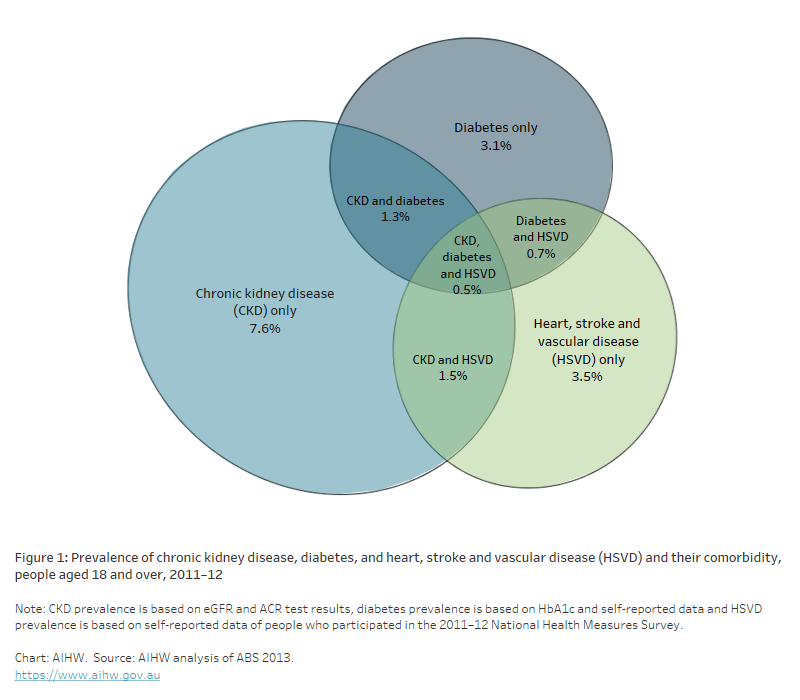
Aboriginal and Torres Strait Islander people
Based on the ABS 2012–13 National Aboriginal and Torres Strait Islander Health Survey, an estimated 86,800 Indigenous adults aged 18 and over (26%) had biomedical signs of CKD, diabetes, or heart, stroke and vascular disease (AIHW analysis of ABS 2015).
After adjusting for differences in the age structures of the populations, 35% of Indigenous adults had CKD, diabetes, or heart, stroke and vascular disease, compared with 18% of all Australian adults.
An estimated 27,300 Indigenous adults had 2 of CKD, diabetes, or heart, stroke and vascular disease together, and 4,300 Indigenous adults had all 3 conditions together. After adjusting for age, 1.8% of Indigenous adults had all 3 conditions, compared with 0.5% of all Australian adults.
Among 59,300 Indigenous adults with biomedical signs of CKD in 2012–13, almost half (27,000) also had diabetes and/or heart, stroke and vascular disease. Among Indigenous adults with biomedical signs of CKD, 46% also had diabetes and/or heart, stroke and vascular disease, compared with 30% of all Australian adults (Figure 2).
Figure 2: Prevalence of chronic kidney disease, diabetes and heart, stroke and vascular disease (HSVD) and their comorbidity, Aboriginal and Torres Strait Islander people aged 18 and over, 2012–13
The Venn diagram shows the overlapping proportion of Aboriginal and Torres Strait Islander adults who had chronic kidney disease, diabetes or heart, stroke, and vascular disease in 2011-12. An estimated 9.7% had CKD only and 1.3% were living with all 3 conditions.

Hospitalisations with chronic kidney disease, diabetes and cardiovascular disease
Hospital comorbidity
On this web page, where a person has 2 or more of CKD, diabetes or cardiovascular disease present in the record of their episode of hospitalisation, it is referred to as comorbidity.
Dialysis (including both haemodialysis and peritoneal dialysis) hospitalisations have been excluded from this analysis, because they are often performed as routine treatments on a same-day basis and usually have no other comorbid diagnoses recorded.
In 2020–21, there were around 2.2 million non-dialysis hospitalisations of people aged 18 or over in which CKD, diabetes or cardiovascular disease was recorded as the principal and/or an additional diagnosis. This equates to 23% of all non-dialysis hospitalisations for people aged 18 and over.
Of these, 383,000 (17%) included CKD, either alone (82,700 or 3.8%), or in combination with diabetes and/or cardiovascular disease (301,000 or 14%) (Figure 3).
CKD was more commonly comorbid with diabetes (139,000 or 6.3%) than with cardiovascular disease (51,800 or 2.4%); however, it should be noted that diabetes is universally coded on a patient’s hospital record.
There were a further 110,000 hospitalisations (5.0%) where all 3 diseases were present. More than 1 in 100 hospitalisations of people aged 18 and over in 2020–21 involved all 3 diagnoses of CKD, cardiovascular disease and diabetes.
Figure 3: Hospitalisations with chronic kidney disease, diabetes and cardiovascular disease (CVD), people aged 18 and over, 2020–21
The Venn diagram shows the overlapping proportion of hospitalisations among adults in 2020–21 with chronic kidney disease, diabetes or cardiovascular disease as the principal and/or additional diagnosis. Among the hospitalisations for these conditions 3.8% were for CKD only, and 5.0% of hospitalisations were for all 3 conditions.
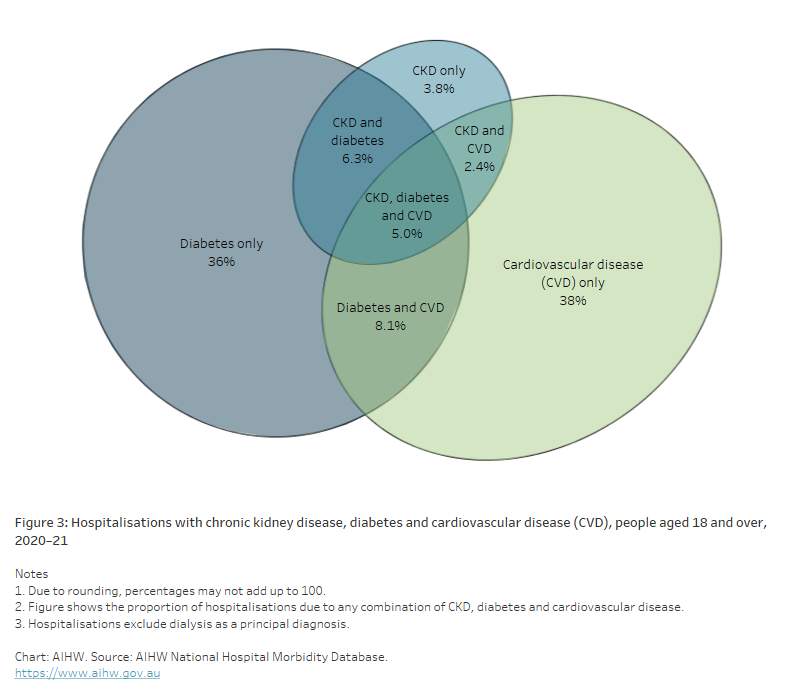
Variation by age and sex
The rate of hospitalisation with comorbidity of CKD, diabetes and/or cardiovascular disease increases with age.
In 2020–21, for example, people aged 65 and over were 5.0 times as likely to have a combination of CKD and diabetes recorded on their hospital record as people aged 45–64 (2,400 and 477 per 100,000 population).
Men were more likely to be hospitalised with comorbidity than women. After adjusting for age, the rate of hospitalisation where all 3 diseases were recorded was 1.7 times as high for men as for women.
Hospital comorbidity in the Aboriginal and Torres Strait Islander population
In 2020–21, there were 96,600 non-dialysis hospitalisations of Indigenous Australians aged 18 and over where CKD, diabetes or cardiovascular disease was present as a principal diagnosis and/or additional diagnosis.
Of these hospitalisations, 34,800 (36%) recorded 2 or 3 of the diseases – 15,700 (16%) recorded CKD and diabetes together, 1,800 (1.8%) recorded CKD and cardiovascular disease, 8,400 (8.7%) recorded cardiovascular disease and diabetes, and 8,900 (9.2%) recorded all 3 diseases (Figure 4).
Among people with any diagnosis of CKD, diabetes or cardiovascular disease, a higher proportion of Indigenous adults had comorbidity in their record of hospitalisation, compared with non-Indigenous adults (36% and 21%). The proportion of Indigenous hospitalisations with all 3 diseases (9.2%) was also higher than that in the non-Indigenous population (4.9%).
After adjusting for age differences in the populations, the rate of hospitalisation of Indigenous Australians recording all 3 diseases was 5.8 times as high as the rate of non-Indigenous people.
Figure 4: Hospitalisations with chronic kidney disease, diabetes and cardiovascular disease (CVD), Aboriginal and Torres Strait Islander people aged 18 and over, 2020–21
The Venn diagram shows the overlapping proportion of hospitalisations among Aboriginal and Torres Strait Islander adults in 2020–21 with chronic kidney disease, diabetes, or cardiovascular disease as the principal and/or additional diagnosis. Among the hospitalisations for these conditions, 3.8% were for CKD only and 9.2% of hospitalisations were for all 3 conditions.
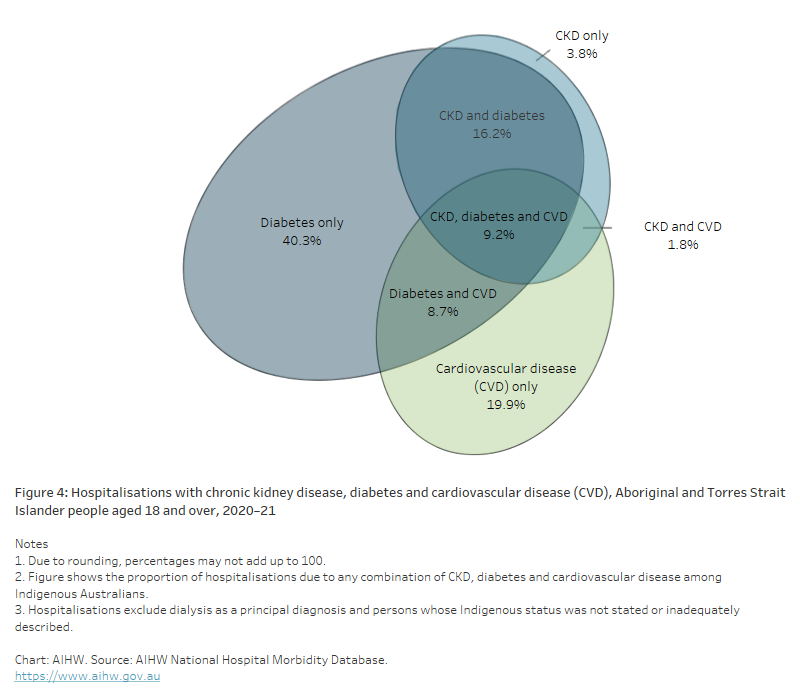
Comorbidities of people receiving kidney replacement therapy
The Australia and New Zealand Dialysis and Transplant (ANZDATA) Registry collects information on the comorbidities of people who receive kidney replacement therapy (KRT) for kidney failure (ANZDATA 2022).
Of the 28,500 people who received KRT for kidney failure in 2021:
- 12,500 (44%) had type 1 or type 2 diabetes
- 9,600 (33%) had known or suspected coronary heart disease
- 5,700 (20%) had known or suspected peripheral artery disease
- 4,300 (15%) had known or suspected chronic lung disease
- 3,400 (12%) had known or suspected cerebrovascular disease (mostly stroke).
Of the 3,300 people who started KRT for kidney failure in 2021:
- more than half (1,700 or 51%) had type 1 or type 2 diabetes
- 1,100 (34%) had known or suspected coronary heart disease
- 642 (20%) had known or suspected peripheral artery disease
- 457 (14%) had known or suspected chronic lung disease
- 362 (11%) had known or suspected cerebrovascular disease (mostly stroke).
The presence of comorbid diabetes on commencement of KRT has increased over the past 2 decades (Figure 5). In contrast, the presence of other comorbid conditions has declined since 2011.
Figure 5: Comorbidities of new kidney failure with replacement therapy patients, 2000 to 2021
The line chart shows the trend in comorbidities across 5 conditions for people with new cases of kidney failure with replacement therapy, from 2000 to 2021. In 2021, diabetes was the most common comorbidity for new patients receiving KRT (51%), followed by coronary heart disease (34%), peripheral arterial disease (20%), chronic lung disease (14%) and cerebrovascular disease (11%). Over time, the proportion of new cases of kidney failure with replacement therapy who had comorbid diabetes has risen, while the remaining comorbidities have been relatively stable.
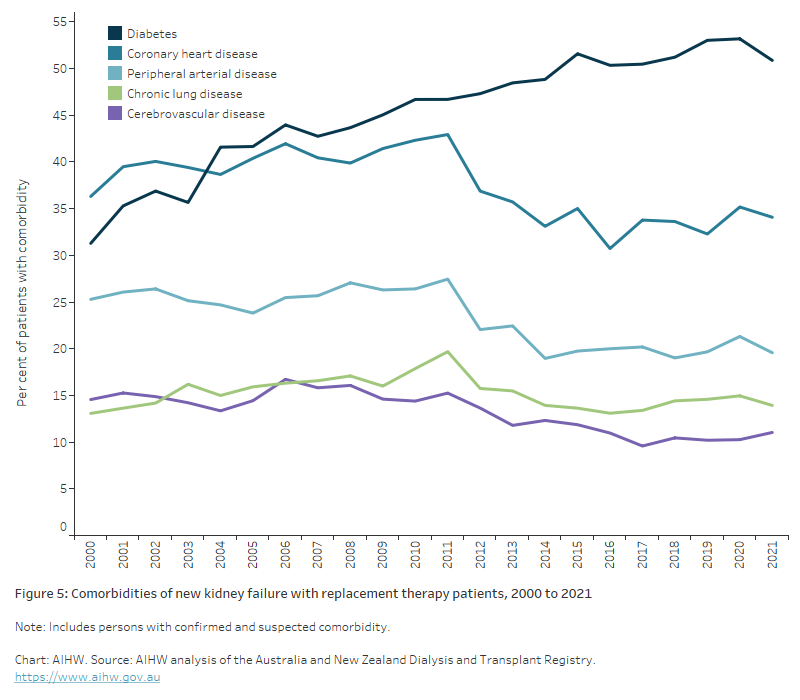
Deaths from chronic kidney disease, diabetes and cardiovascular disease
Often, more than one disease contributes to a death. Along with the underlying cause of death, a medical practitioner or coroner will also record associated causes on a death certificate. The most complete representation of cause-of-death will consider the contribution of both underlying and associated causes.
CKD and diabetes are more likely to be recorded as associated causes of death, unlike cardiovascular disease which is a common underlying cause of death. Both CKD and diabetes are known to be under-reported in national mortality statistics and might be omitted from death certificates as contributory causes of death (McEwen et al. 2011; Sypek et al. 2018).
Association of chronic kidney disease, diabetes and cardiovascular disease deaths
Of the 169,800 deaths registered among persons aged 18 and over in Australia in 2021, CKD, diabetes and cardiovascular disease were listed as underlying or associated causes in 99,100 (58%) of these.
CKD was listed as either an underlying or associated cause of death in 19,900 deaths (12% of adult deaths). Cardiovascular disease was listed with 90,900 deaths (54% of adult deaths) and diabetes with 19,300 deaths (11% of adult deaths).
Of the 19,900 adult CKD deaths registered in 2021, 79% (15,700) also involved a diagnosis of either CVD or diabetes.
Of all deaths among adults in 2021:
- 26,800 (16%) had at least 2 of CKD, CVD and diabetes
- 4,200 (2.5%) had CKD only recorded
- 890 (0.5%) had CKD and diabetes
- 10,600 (6.3%) had CKD and CVD
- 11,100 (6.5%) had CVD and diabetes
- 4,200 (2.4%) had all 3 conditions recorded (Figure 6).
Figure 6: Proportion of deaths with CKD, cardiovascular disease (CVD) and diabetes listed as any cause of death, persons aged 18 and over, 2021
The Venn diagram shows the proportion of deaths among adults in 2020 with chronic kidney disease, diabetes or cardiovascular disease as any cause of death. Among deaths from these conditions, CKD was recorded as the only cause in 4.3% of deaths, and all 3 diseases were recorded as the underlying or associated cause in 4.2% of deaths.
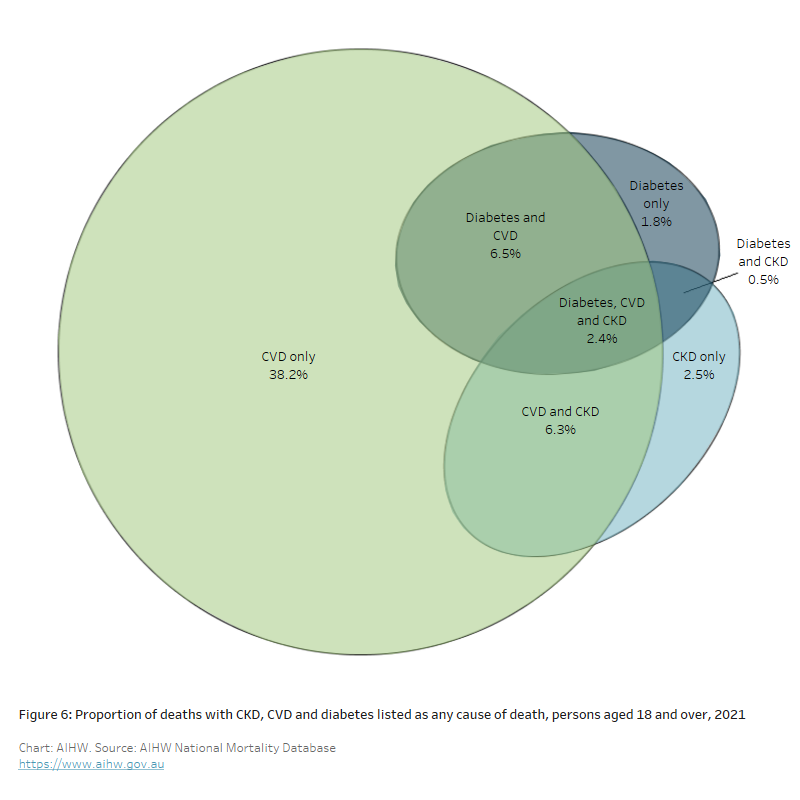
Diseases commonly associated with chronic kidney disease deaths
When CKD is the underlying cause of death, cardiovascular disease and/or diabetes are often listed as associated causes of death (Table 1).
Acute kidney failure (ICD-10 N17) was also often listed as an associated cause of death when the underlying cause of death was CKD.
Other causes that were commonly associated with CKD deaths in 2021 included heart failure (ICD–10 I50), essential (primary) hypertension (I10), chronic ischaemic heart disease (I25) and type 2 diabetes mellitus (E11).
| Associated cause | Number | Per cent of all CKD deaths as underlying cause |
|---|---|---|
|
Diseases of the circulatory system |
4,961 |
41.4 |
|
Heart failure (I50) |
1,218 |
10.2 |
|
Essential (primary) hypertension (I10) |
999 |
8.3 |
|
Chronic ischaemic heart disease (I25) |
628 |
5.2 |
|
Endocrine, nutritional and metabolic diseases |
1,649 |
13.7 |
|
Type 2 diabetes mellitus (E11) |
679 |
5.7 |
|
Unspecified diabetes mellitus (E14) |
463 |
3.9 |
|
Other disorders of fluid, electrolyte and acid-base balance (E87) |
132 |
1.1 |
|
Diseases of the respiratory system |
961 |
8.0 |
|
Pneumonia, organism unspecified (J18) |
226 |
1.9 |
|
Other chronic obstructive pulmonary disease (J44) |
211 |
1.8 |
|
Pulmonary oedema (J81) |
134 |
1.1 |
|
Diseases of the genitourinary system |
817 |
6.8 |
|
Acute kidney failure (N17) |
621 |
5.2 |
|
Other disorders of urinary system (N39) |
160 |
1.3 |
Note: Excludes death records where CKD was listed as an associated cause (see ICD 10 codes in Data sources).
Source: AIHW National Mortality Database.
Chronic kidney disease associated with other causes of death
CKD was listed as an associated cause of death for 9.0% of all deaths registered in 2021 (15,400 of 171,000 total deaths).
When CKD was listed as an associated cause, the most common underlying causes of death included chronic ischaemic heart disease, acute myocardial infarction, heart failure, other chronic obstructive pulmonary disease and type 2 diabetes mellitus (Table 2).
| Underlying cause | Number | Per cent of all CKD deaths as associated cause |
|---|---|---|
|
Diseases of the circulatory system |
5,136 |
33.4 |
|
Chronic ischaemic heart disease (I25) |
1,666 |
10.8 |
|
Acute myocardial infarction (I21) |
682 |
4.4 |
|
Heart failure (I50) |
654 |
4.2 |
|
Cancers |
3,104 |
20.2 |
|
Malignant neoplasm of prostate (C61) |
363 |
2.4 |
|
Malignant neoplasm of bronchus and lung (C34) |
303 |
2.0 |
|
Multiple myeloma and malignant plasma cell neoplasms (C90) |
220 |
1.4 |
|
Endocrine, nutritional and metabolic diseases |
1,449 |
9.4 |
|
Type 2 diabetes mellitus (E11) |
620 |
4.0 |
|
Unspecified diabetes mellitus (E14) |
429 |
2.8 |
|
Diseases of the respiratory system |
1,235 |
8.0 |
|
Other chronic obstructive pulmonary disease (J44) |
624 |
4.1 |
|
Pneumonia, organism unspecified (J18) |
213 |
1.4 |
|
Other interstitial pulmonary diseases (J84) |
107 |
0.7 |
Note: Excludes death records where CKD was listed as an underlying cause (see ICD 10 codes in Data sources).
Source: AIHW National Mortality Database.
ABS (Australian Bureau of Statistics) (2013a) Australian Health Survey: biomedical results for chronic diseases, ABS, Australian Government, accessed 1 February 2022.
ABS (2013b) Microdata: Australian Health Survey: core content – risk factors and selected health conditions, 2011–12, AIHW analysis of detailed microdata, ABS, Australian Government, accessed 20 October 2021.
ABS (2015) Microdata: Australian Aboriginal and Torres Strait Islander Health Survey, core content – risk factors and selected health conditions, 2012–13, AIHW analysis of detailed microdata, ABS, Australian Government, accessed 18 May 2022.
ABS (2018a) National Health Survey: first results, 2017–18, ABS, Australian Government, accessed 1 February 2022.
ABS (2018b) Kidney disease, ABS, Australian Government, accessed 1 February 2022.
AIHW (Australian Institute of Health and Welfare), Tong B, Stevenson C (2007) Comorbidity of cardiovascular disease, diabetes and chronic kidney disease in Australia, AIHW, Australian Government, accessed 13 July 2022.
AIHW (2014) Cardiovascular disease, diabetes and chronic kidney disease – Australian facts: prevalence and incidence, AIHW, Australian Government, accessed 1 February 2022.
AIHW (2015) Cardiovascular disease, diabetes and chronic kidney disease – Australian facts: Aboriginal and Torres Strait Islander people, AIHW, Australian Government, accessed 1 February 2022.
AIHW (2021) Chronic condition multimorbidity, AIHW, Australian Government, accessed 1 February 2022.
ANZDATA (Australia and New Zealand Dialysis and Transplant Registry) (2022) ANZDATA 45th Annual Report 2022, ANZDATA, accessed 15 March 2023.
McEwen L, Karter A, Curb J, Marrero D, Crosson J and Herman W (2011) Temporal trends in recording of diabetes on death certificates: results from Translating Research into Action for Diabetes (TRIAD). Diabetes Care, 34:1529–1533, doi: 10.2337/dc10-2312.
Sypek MP, Dansie KB, Clayton P, Webster AC and McDonald S (2018) Comparison of cause of death between Australian and New Zealand Dialysis and Transplant Registry and the Australian National Death Index. Nephrology, 24:322–329, doi: 10.1111/nep.13250.


